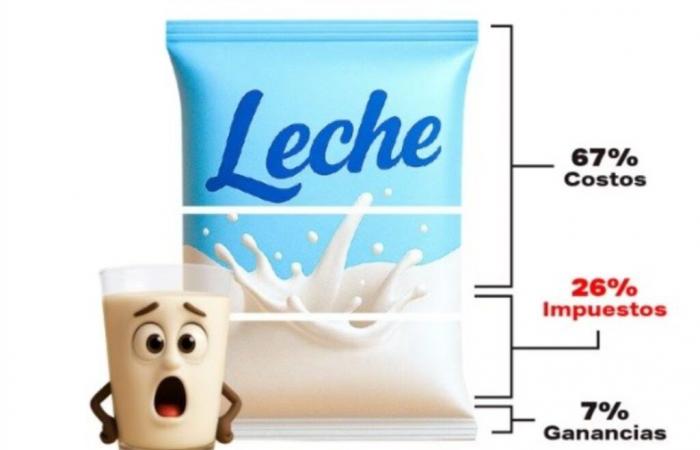“Every four pancitos, we eat one of taxes,” said a report by the Agricultural Foundation for the Development of Argentina (FADA), which analyzed the impact of fiscal pressure on basic food prices.
In this regard, they exemplified that in the price paid for many of the products, there are more taxes than profit. For example, in milk there are 26% of taxes and 7% profit and in the PAN 24% taxes and 16% profits.
Also read: The vaccine meat rose 4% in April and accumulates in the year an increase well above the general inflation
“The same thing happens at lunch or dinner. If we go to the butcher shop, for every kilo of meat we are taking a tax room. There are 25% taxes and 15% earnings,” warns Nicolle Pisani Claro, chief economist of Fada.
On that, he adds: “In other words, every $ 10,000, we are paying $ 2,500 of tax burden. This is also repeated in many of the products, and in some cases this is becoming more visible to the consumer, for the application of the new transparency measure that asks to detail the” price with and without taxes “in the gondolas and tickets.”
What do we pay in food
“The price we pay is composed of three major categories: the costs of making that product, the profit and taxes that are paid in this process. But what are those taxes and what is behind a product in terms of costs?
The taxes that stand out are: VAT at the national level, gross income in the provincial and fees to industries and shops at the municipal level, ”says Antonella Semadeni, economist from Fada. And of the total of those taxes, more than 70% correspond to nationals.
“As for the main costs, for example, to elaborate the PAN we have: electricity, which weighs even more for updates in rates, raw material, transportation, rentals and staff. For example, freight represents 2% of the price to the consumer,” describes Pisani Claro.
“Until our table reaches, at each stage of the product there are costs and taxes that must be faced, as well as the profits of a productive activity. That taxes exceed gain, it is a situation that can become unfair since, for example, in the milk chain the entire production process is affected by climatic issues, subject to the price of corn with which the cows are fed, to the products related to the health of the health, the products related to the health of the health, the products related to For transport. There are many variables that face.
In the midst of all that, the State, through taxes, is present in all links and does not face any risk, ”analyzes Semadeni.
How prices are composed
“The price we pay for our food is not random or capricious and can be broken down into different ways. We do this in this report,” explains Semadeni.
For example, in the case of bread, from the field to the table the price multiplies 12 times. What is in the process?: 60% of costs of producing bread, 24% taxes and 16% profits.
Also read: “The strawberry of dessert”: a libertarian legislator trusts that President Milei will lower the withholdings
In the case of meat, the price is composed of 60% costs. To reach the bifes that we buy, a process that takes a long time, with important costs such as the land where animals, health and food, transport, and staff are necessary.
In milk 67% are costs, 26% are taxes and only 7% are profits. For example, for the tambo, the costs that raised the most in this last measurement were the feeding of cows and all costs related to commercialization.
when studying the composition of prices in a chronological way, we see in the price of the bread that 8% corresponds to the wheat, 4% to the mill, 64% to the bakery and 24% taxes.
In meat 28% is breeding, 24% feedlot, 2% fridge, 21% butcher shop and 25% taxes. In milk 28% is tambo, 26% industry, 20% trade and 26% taxes.
Price with and without taxes: What is this measure for?
“It is a way of educating consumers, so that there is a notion of the weight of taxes in the products we buy and understand the importance of reviewing the entire tax system in general. The Fada report also goes in that line of providing information and even tries to go further, detailing how the price is composed through all links and taking into account taxes at all levels of government,” says Pisani Claro.
“We believe that this helps to demolish certain myths about how prices that often work important public policies for citizens and for productive areas are made up. For example, for many years it was wrongly believed that the decline in withholdings, by impacting the price of grains, was going to bring a significant increase in the price of basic products when it is not.
Actually, this report shows that 90% of the price of the products corresponds to multiple factors such as taxes, transport, rentals, salaries, services, among many others.
That is why we believe that it is important to make visible and knock down certain myths to focus and focus on what we need as consumers and for the entire production and elaboration process, ”concludes Semadeni.
Price composition in numbers
● 1,000 of every 4,000 pesos that we pay in meat, milk and bread, are taxes.
● In total taxes to these foods: 3 thousand of every 4 thousand pesos, they are national taxes.
● Every 4 bollitos of bread, we eat 1 taxes.
● Bread price: 60% are costs, 24% taxes and 16% gain.
● Wheat represents only 8% of the price.
● From the field to the bakery, the price is multiplied by 12 in its route.
● Bread price in links: wheat represents 8%, the mill at 4%, the bakery 64%and taxes 24%.
● We have a glass glass for each milk sachet.
● 67% are production costs, 26% taxes and 7% gain.
● Corn represents 4% of the price of Sachet to the consumer.
● The price of milk is multiplied by 3.5 from the field to the gondola.
● Price milk by links: the tambo represents 28%, the industry 26%, trade 20%and taxes 26%.
● We eat a fourth kilo of taxes for each kilo of meat.
● 25% are taxes, 59% are costs and 15% gain.
● Corn represents only 9% of the final price of meat.
● MEAT PRICE BY links: The breeding represents 28%, the 24%feedlot, 2%refrigerator, carnage 21%and taxes 25%.






